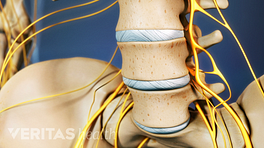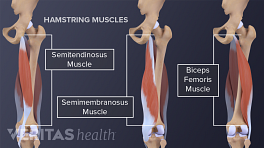Sciatica Exercises for Degenerative Disc Disease
For disc degeneration and resulting sciatica, a program of dynamic lumbar stabilization exercises is usually recommended. These exercises help alleviate sciatica by training the body to maintain a comfortable posture for the lumbar spine and pelvis during everyday activities. These exercises can improve the proprioception—or the body’s ability to sense movement—of the lumbar spine, and reduce the excess motion at the spinal segments. This in turn, will reduce the irritation at these segments, relieving pain and protecting against further damage.
How to Perform a Pelvic Tilt
Let’s do the pelvic tilt. Pelvic tilt is an important technique because it is the basis of many of the other exercises we will be doing later. To begin the pelvic tilt, lay on your back. Keep your knees bent with your feet flat on the floor. Now think about pulling your belly button in towards your spine. Your back will automatically flatten towards the floor. As you pull your belly button in, your pelvis will roll up towards your chest. Be very careful not to push with your legs to make your pelvis roll.
This is a position you will hold while you are performing many of the other exercises.
Prone Leg Raise Exercise
Now we will perform the prone leg raise exercise. To begin, lie on your stomach and pull your belly up towards your spine again, locking your pelvis into position similar to the pelvic tilt. Keeping your legs straight, slowly raise one leg at a time only an inch or 2. Again try to avoid letting your pelvis rock back and forth.
To make it easier to monitor your pelvic motion, it is often helpful to place your fists under the front of your pelvis.
Hook-Lying March Exercises
The hook-lying march exercise helps with lumbar stabilization. Begin by lying on your back and start with performing a pelvic tilt. Keep your knees bent and slowly raise one leg at a time only an inch or 2. The goal here is to do this without rolling your pelvis side to side. And if you lock your pelvis in position, it should stay fairly straight. It may be easier to monitor your pelvic motion by placing your fingers behind your pelvis.
You should be able to speak while doing these exercises, so you are not overworking yourself. If you are having a hard time raising the entire leg without moving your pelvis, begin by just raising on heel at a time and alternate.
To advance the hook-lying march exercise, perform the same leg movement but keep your arms straight up toward the ceiling. Now lock your pelvis in position, and as you raise your left leg, drop your right arm down over your head. Return to the starting position, and alternate sides. Don’t let your pelvis tilt up or arch your back. Your back should stay relatively still while performing these exercises.
Bridging Exercise
Now we’ll perform the bridging exercise. Begin by lying on your back and performing a pelvic tilt. Raise your hips up in the air while keeping your trunk straight. Don’t roll your pelvis up first. When done correctly, everything should leave the floor together and come back to the floor together. At the top do not arch your back. Try to remain as straight as possible through the trunk.
To advance the bridging exercise, place your arms across your chest and start with performing a regular bridge. Once at the top, keep your trunk and thighs still and straighten out one knee at a time, alternating each leg. Be careful not to let the pelvis drop.
This video accompanies the article: Exercise for Sciatica from Degenerative Disc Disease.











